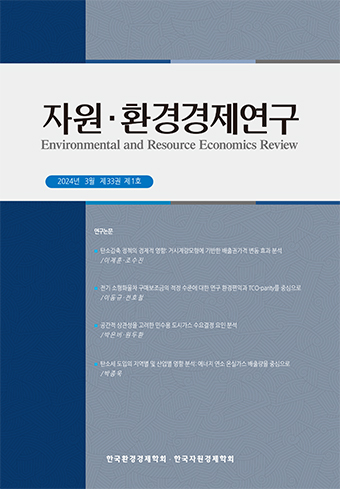Policy Paper
Abstract
References
Information
Industrial groups (representing the polluters) and environmental non-governmental organizations (representing the victims) respond differently to various environmental policy instruments. As the affected group’s power is large either politically or economically, it is unlikely that a single instrument will be actually selected despite being effective or efficient because of the high political costs associated with it. In this paper, we focus on the political role that energy subsidies play in creating a compromise between energy consuming polluters and victims of pollution. The use of a Dolbear (1967)'s triangle Edgeworth box model makes it possible to examine how policy selection affects the income distribution and welfare levels of two groups. The effects of a single policy instrument of either direct regulation or tax are compared with those of a policy mix that includes energy subsidies. We found that the addition of energy subsidies would increase the chance of compromise between polluters and victims.
어느 한 집단이 정치적, 혹은 경제적으로 영향력이 클 경우 정책수단이 비록 효과적 혹은 효율적이라도 선택될 가능성은 현실적으로 낮다. 왜냐하면 그 과정에서 높은 정치적 비용이 수반되기 때문이다. 본 논문에서는 에너지를 소비하는 공해발생자와 공해피해자 간 타협을 도출하는 데 있어서 에너지보조금의 정치적 역할을 분석한다. Dolbear(1967)의 삼각 에즈워즈 상자 모형을 이용하여 정책선택이 두 집단의 소득분배와 후생수준에 미치는 영향을 중심으로 직접규제와 조세의 단일 정책수단 도입 효과와 에너지보조금을 포함한 정책조합의 효과를 비교한다. 분석결과, 에너지보조금이 사용됨으로써 공해발생자와 피해자 간의 타협 가능성은 증가하는 것으로 나타났다.
- Baumol, W.J. and W.E. Oates, The Theory of Environmental Policy, Cambridge: Cambridge University Press, 1988.10.1017/CBO9781139173513
- Baumol, W.J., W.E Oates, and S.A.B. Blackman, Economics, Environmental Policy, and the Quality of Life, NJ: Prentice-Hall, 1979.
- Buchanan, J. and G. Tullok, “Polluters Profits and Political Response: Direct Controls versus Taxes,” American Economic Review, Vol. 65, 1975, pp. 139~147.
- Coase, R., “The Problem of Social Cost,” Journal of Law and Economics, Vol. 3, 1960, pp. 1~44.10.1086/466560
- Dolbear, F.T., “On the Theory of Optimum Externality,” American Economic Review, Vol. 57, 1967, pp. 90~103.
- Dunlap, R.E. and A.G. Mertig, American Environmentalism: The US Environmental Movement, 1970-1990, Abingdon: Taylor and Francis, 1992.
- Green Fiscal Commission, The Case for Green Fiscal Reform-Final Report of the UK, 2009.http://www.greenfiscalcommission.org.uk/images/uploads/GFC_FinalReport.pdf.
- Hahn, R.W., “Economic Prescriptions for Environmental Problems: How the Patient Followed the Doctor’s Orders,” Journal of Economic Perspectives, Vol. 3, 1989, pp. 95~114.10.1257/jep.3.2.95
- Hahn, R.W., “The Political Economy of Environmental Regulation: Towards a Unifying Framework,” Public Choice, Vol. 65, 1990, pp. 21~47.10.1007/BF00139289
- Hamamoto, M., “Process of Environmental Policy Determination,” International Public Economy Studies, Vol. 8, 1998, pp. 26~33.
- Hamamoto, M., Political Economy of Emission Trading Scheme (in Japanese), Tokyo: Yuhikaku, 2008.
- IEA, World Energy Outlook 2015 Special Report: Energy and Climate Change/ on the Case Studies of Energy Subsidies for Some Selected Countries of the World, 2015. http://www.iea.org/publications/freepublications/publication/WEO2015SpecialReportonEnergyandClimateChange.pdf.
- Keohane, N.O., R.L. Revesz, and R.N. Stavins, “The Positive Political Economy of Instrument Choice in Environmental Policy,” in A. Panagariya, P. Portney, and R. Schwab (eds.), Environmental and public economics: Essays in honor of Wallace E. Oates, pp. 89~125, Cheltenham: Edward Elgar, 1999.
- Lee, S., “Comparative Analysis of Institutional Designs and Policy Processes toward the Introduction of Emissions Trading Systems in Japan and Korea,” in T. Morotomi (ed.), Low Carbon Development and Low Carbon Society, Tokyo: United Nations University Press, 2014.
- Lee, S., “Environmental Subsidies by Fiscal Investment and Loan in Japan,” The Research and Studies (in Japanese), Vol. 18, 1998. pp. 15~31.
- Lee, S., H. Pollitt, and K. Ueta, “An Assessment of Japanese Carbon Tax Reform Using the E3MG Econometric Model,” Scientific World Journal, 835917, 2012, pp. 1~9.10.1100/2012/835917
- Lee, S., Theory and Practice of Environmental Subsidy (in Japanese), Nagoya: Nagoya University Press, 2004.
- OECD, Taxation, Innovation and the Environment, Policy Brief, 2010.http://www.oecd.org/environment/tools-evaluation/48178034.pdf.
- Opschoor, J., Economic Instruments for Environmental Protection in the Netherlands, OECD, 1986.
- Oyama, A., “Internality and Existence of Third Party,”Economic Magazine (in Japanese), 1998, pp. 129~143.
- Pigou, A.C., The Economics of Welfare, London: Macmillan, 1920.
- Turner, R.K., D. Pearce, and I. Bateman, Environmental Economics: An Elementary Introduction, Baltimore, MD: Johns Hopkins University Press, 1993.
- Young, M.D., Sustainable Investment and Resource Use, UNESCO, 1992.
- Publisher :Environmental and Resource Economics Review
- Publisher(Ko) :자원 · 환경경제연구
- Journal Title :자원·환경경제연구
- Journal Title(Ko) :Environmental and Resource Economics Review
- Volume : 27
- No :4
- Pages :725-743
- DOI :https://doi.org/10.15266/KEREA.2018.27.4.725



 자원·환경경제연구
자원·환경경제연구






